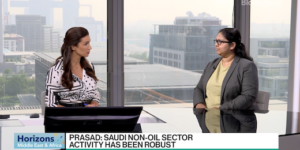This article originally appeared here on Bloomberg, dated 22 Dec 2014 and was later republished here.
The boom that adorned Gulf Arab monarchies with glittering towers, swelled their sovereign funds and kept unrest largely at bay may be over after oil prices dropped by almost 50 percent in the last six months.
The sheikdoms have used the oil wealth to remake their region. Landmarks include man-made islands on reclaimed land, as well as financial centers, airports and ports that turned the Arabian desert into a banking and travel hub. The money was also deployed to ward off social unrest that spread through the Middle East during the Arab Spring.
“The region has had 10 years of abundance,” said Simon Williams, HSBC Holdings Plc’s chief economist for central and eastern Europe, the Middle East and North Africa. “But that decade of plenty is done. The drop in oil prices will hurt performance in the near term, even if the Gulf’s buffers are powerful enough to ensure there’s no crisis.”
Brent crude, which has averaged $102 a barrel since the end of 2009, plunged to about $60 by the end of last week. The slump accelerated after the Organization of Petroleum Exporting Countries, whose top producer is Saudi Arabia, decided in November to keep output unchanged. At $65 a barrel, the six nations of the Gulf Cooperation Council, which hold about a third of the world’s crude reserves, would run a combined budget deficit of about 6 percent of gross domestic product, according to Arqaam Capital, a Dubai-based investment bank.
Growth Forecast
Cheaper oil “will force a reassessment of the ambitious infrastructure investment program” in the region, Qatar National Bank said in a report. One exception is likely to be Qatar, which is spending on infrastructure to host the 2022 soccer World Cup final, QNB said. The oil-price drop has already prompted economists to cut next year’s growth estimates for Saudi Arabia, the United Arab Emirates and Kuwait, according to data compiled by Bloomberg.
The Bloomberg GCC 200 Index (BGCC200) has fallen 8.5 percent in the past six months, while Saudi Arabia’s Tadawul All Share Index, the benchmark of the Arab world’s biggest stock market, is down 12 percent.
The GCC spending spree hasn’t resolved problems such as high youth unemployment, especially in Saudi Arabia, where the rate was close to 30 percent in 2012, according to the International Monetary Fund. Despite total employment growth averaging near 8.5 percent, employment growth for Saudis was 4.6 percent in the years between 2010 and 2012, the IMF said in July last year.
Monarchies Cushioned
The spending did help insulate the monarchies from the revolts of 2011.
That year, King Abdullah of Saudi Arabia allocated $130 billion to create jobs, build homes and raise salaries, while Qatar ordered $8.2 billion in to boost pensions and pay for civil servants. When protests broke out in Bahrain, the only GCC country to experience major upheaval, and to a lesser extent in Oman, their Gulf neighbors pledged $20 billion in assistance.
“Lower oil prices will be a real test,” said Crispin Hawes, managing director of research firm Teneo Intelligence in London. “If there was a problem in the past, they threw sacks of cash at it.”
That cash also financed a global spending spree. Qatar, the richest country in the world on a per-capita basis, has holdings in Harrods department store in London and in banks such as Barclays Plc. Abu Dhabi’s national carrier Etihad Airways made a string of purchases, including a multibillion-dollar investment in Alitalia SpA.
Ample Reserves
The richer GCC countries were saving while they spent. Saudi Arabia, the Arab world’s biggest economy, has seen its net foreign assets jump 80 percent to $773 billion since 2009, according to central bank data. The U.A.E. and Qatar have two of the world’s largest sovereign wealth funds.
With those funds available, “my guess is that the Gulf states will just draw down resources” rather than “do anything really serious,” said Gregory Gause, head of the International Affairs Department at Texas A&M University.
Before they have to tap their reserves, oil prices may rebound.
The oil market will recover with global economic growth, Saudi Arabia Oil Minister Ali Al-Naimi said in Abu Dhabi on Dec. 21. “Fossil fuel will remain the main source of energy for decades to come,” he said. Oil surged from a five-year low at the end of last week after Al-Naimi said the slump in prices was temporary.
Fuel Subsidies
In the meantime, there’s no guarantee that a spending strategy would work because the reserve cushion may not last long without economic adjustments, said Nasser Saidi, president of Nasser Saidi & Associates in Dubai and former chief economist of the Dubai International Financial Centre.
“Growing government spending has been eating into those surpluses,” he said. “You’re going to have to adjust to the lower oil prices. The implication is that you either have to start to reduce spending or you need new sources of revenue, or both.”
Persian Gulf monarchies maintain high fuel and power subsidies, which are used to transfer oil wealth to their citizens. Cutting them is politically sensitive after domestic discontent led to the overturning of governments in Tunisia, Libya and Egypt since 2011.
Gulf leaders say they’re aware of tougher times ahead.
‘Line of Defense’
The Saudi cabinet said today the economy can “endure temporary fluctuations in oil revenue, which are normal.” Saudi Finance Minister Ibrahim al-Assaf said this month that the kingdom will use its financial reserves as a “line of defense” against lower oil prices, and will keep funding “massive” development projects.
Oman, which lacks assets on that scale, is considering a freeze on public sector hiring, Finance Minister Darwish Al Balushi said last month.
In Kuwait, which has seen a wave of peaceful protests since 2011, ruler Sheikh Sabah said on Dec. 9 that oil prices are reaching “levels that have started to affect the income and development programs of our countries.”
Economists have begun to cut growth estimates. While the Saudi economy was still forecast to grow 3.6 percent next year in the latest Bloomberg survey between Dec. 12 and Dec. 17, that was down from 4.2 percent three months earlier. The figure dropped to 4 percent from 4.5 percent for the U.A.E., and to 2.4 percent from 2.8 percent for Kuwait.
“The real questions, though, are over the longer term, about how the Gulf generates growth without being able to fall back on ever-rising levels of public spending,” said Williams of HSBC.




